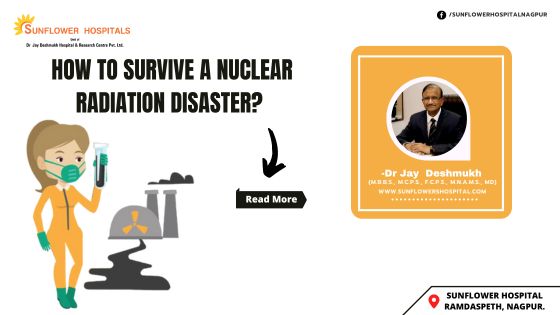What are the important components following a nuclear blast?
A flash of light with a fireball mushroom cloud in the air is the first thing to occur. Extremely high thermal radiation is the next to occur. An air blast will destroy everything en route. An initial pulse of nuclear radiation and a residual fallout will occur. Thermal radiation can increase the temperature by millions of centigrade. This can inflict burns even many miles away from the blast. Within half a mile of the blast, bodies evaporate, and most buildings are destroyed.
What are the positives even in this gloomy scenario?
Depending upon the strength of the device, the damage goes on reducing as one moves away from the detonation site. The nuclear device does not have infinite strength, and the damage could be limited to a few miles only. Many devastating effects can be reduced by sheltering inside.
What to do in case of an emergency arising due to a nuclear explosion?
The main aim should be to get inside, stay inside, and stay calm. Getting inside a building and staying there is called sheltering in place. Once inside a building do not peep around, do not look at the sky and do not rush here and there to save others, even children.
Is your car or bus a safe place to be in?
The inside of a bus or car is the worst place to be in. Vehicles do not offer protection from flash, intense heat, or radiation. The intense light after a nuclear explosion will last for 15 to 60 seconds. The glare could be equivalent to more than 100 Sun energy or light. Stormy air currents will blow away most of the vehicles. Falling trees and electric poles would be an additional misery. Stop your vehicle and rush to the nearest building. Do not move out at least for an hour, as the radiation exposure reduces by 60% after 1 hour.
What about those at home or indoors?
The basements and concrete buildings are the safest. Staying inside concrete buildings for at least 24 hours can save lives. Please stay at home and do not rush outside to bring children from school or classes. The initial few hours after the blast are the most dangerous. Hospitals, schools, colleges, and offices should have emergency plans in place. A nuclear radiation emergency can occur during a war or an accidental disaster in a nuclear reactor. The threat of nuclear explosion, man-made or accidental, always remains a possibility. People need to save themselves and others, protecting lives and minimizing the damage.
What to do once inside a concrete building?
Lock all doors and windows. Go to the basement or the middle floor in case there is no basement. In a flat, go to the middle room as the walls and roof are re not exposed to radiation. Please close down air conditioners and fans to prevent radiation from getting in along with the air, and stay away from windows and doors. Doors can fly open and walls can cave in. The best place could be toilets with few windows. If someone asks for shelter after a radiation injury, let him in. It
would not endanger other lives.
How to do decontamination?
This is to get radioactive material off the body. Remove the outer layer of your clothing, have a bath and gently wash with lots of water. Do not scratch the skin. Do not use creams as this will make radiation stick to your skin. Drink bottled water or groundwater. Use canned food if possible. Food in the refrigerator would be safe.
What about people in villages?
Mud absorbs radiation well. Strong mud houses in villages could be a safe shelter. People near rivers, swimming pools, and water bodies can stay in the water as this dilutes both radiation and heat.
What about Potassium Iodide tablets?
These are not magic bullets against all radiation odds. It can only protect the thyroid gland from the intake of radioiodine. It does not protect other organs of the body from radiation.
What once the emergency settles?
Nausea, vomiting, headache, and diarrhea occur minutes after radiation exposure and may persist for a few days to weeks. Some may even have fits and coma. Supportive treatment is required. Antibiotics and treatment of dehydration may be the mainstay of treatment. Cutaneous radiation injury may occur in various forms. Blisters and ulcers may occur
Within about half a mile of a nuclear explosion, there is no chance to survive. However, the chances of survival may increase outside the one-mile radius. Basement shelters are the best places to be in, whereas rush-ing inside a vehicle would be the worst place.
Author: Dr Jay Deshmukh
Dr Jay Deshmukh is Chief Physician and Director, Sunflower Hospital, Nagpur Honorary Physician to Honorable Governor of Maharashtra and PondicherryCentral. Dr Jay Deshmukh is an M.B.B.S., M.C.P.S., F.C.P.S., M.N.A.M.S., MD From Internal Medicine – Bombay and New Delhi.


